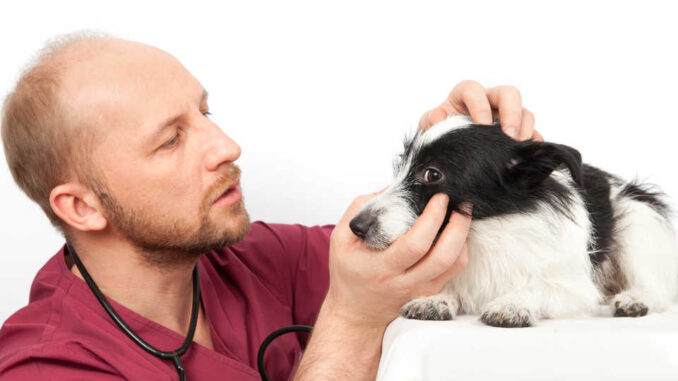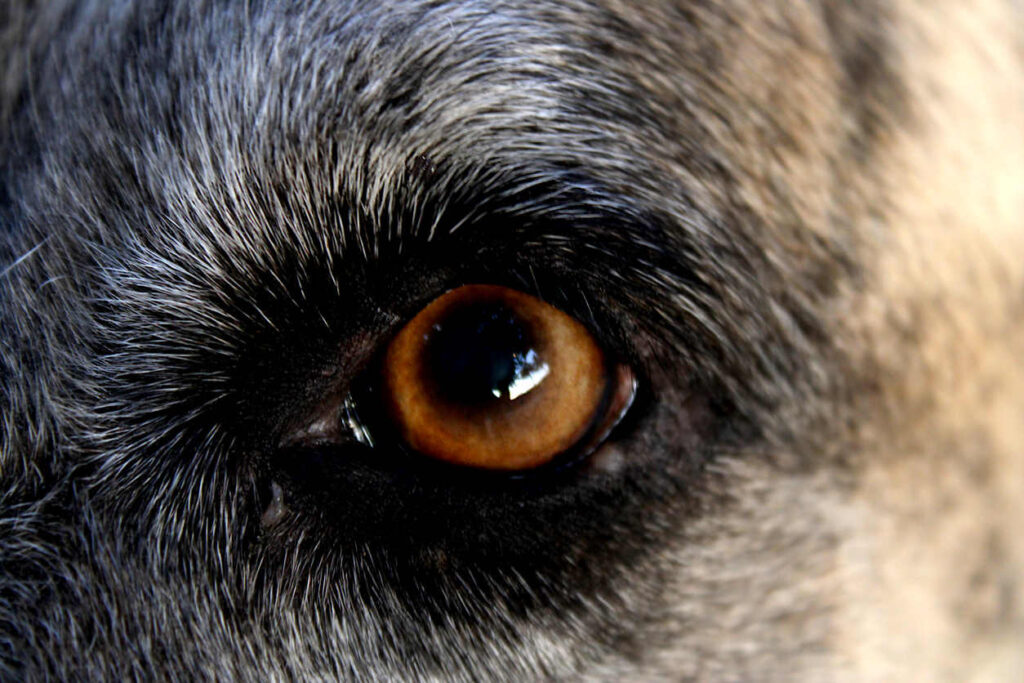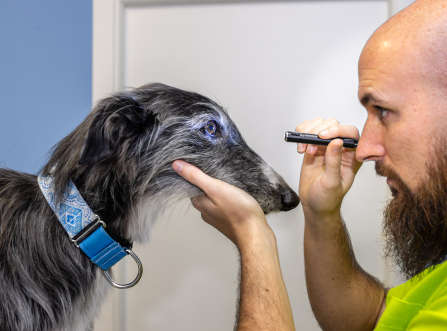
This article was updated on August 10th, 2023

A dog’s pupils dilate, or enlarge, and constrict, or get smaller, multiple times per day. It’s a normal, natural thing that happens depending on the amount of light or in response to something, such as fear or during play. Dilated pupils can also mean that something may be wrong with your canine companion. In this article, we will explain potential reasons why your dog’s eyes may be dilated and what, if anything, you need to do about it.
Top Causes of Dilated Pupils in Dogs

The pupil’s main job is to control the amount of light that gets to the back of the eye. The size of the pupil is changed by a couple of muscles in the iris, or the colored part of the eye. These muscles change the size of the pupil in response to a number of stimuli:
1. Amount of Light
The more light there is outside of the eye, the smaller the pupils will be in order not to let in too much light. The less light there is, the larger the pupils will be in order to get the proper amount of light to the back of the eye. So, when your dog is in a dark room or outside at night, their pupils will dilate in order to let in a sufficient amount of light for their eyes to work properly.
Eyes that are working properly should have a small pupil in bright light and dilated pupil in low light. The pupil size should change freely within a few seconds of a change in light.
2. Emotions
The size of a dog’s pupils can have a lot to do with their emotions. Surprise, fear, pain, excitement, and stress can all cause dilation in the pupils. This is to facilitate the stress response allowing more light into the eye so that an animal can better see to “fight or flight.” Even though playtime might not seem like a stressful time, a dog’s nervous system is still firing on all cylinders, so the body wants to make sure the eyes are well-equipped to handle the excessive movement.
If a pup’s eyes are dilated due to a strong emotion, they should return to normal size after being allowed to calm down for a few minutes.
If a dog’s dilated eyes can’t be attributed to emotion or the amount of light, they should be seen by a veterinarian. An ocular exam to look at the inside of the eye, test the pressures within the eye, and the eye’s normal responses may help reveal the cause of the abnormal dilation.
3. Eye Issues
Injuries or illnesses affecting one or both eyes can cause unnatural dilation, including:
- iris atrophy,
- glaucoma,
- eye tumors,
- blindness,
- an infection, or
- an injury.
In addition to a dilated pupil, dogs may also have watery eyes, constant blinking, cloudiness in their eyes, eye bulging, squinting, redness, or difficulty seeing.
4. Nervous System Issues
Since the size of the pupil is controlled by the nervous system, a defect in that pathway can also be the cause of dilated pupils. Injury, inflammation, infection, or tumors of the brain or spinal cord can all impact the pupil’s ability to change sizes. How do you know if your dog’s dilated pupil is due to nervous system issues? Dogs with any of these issues may also have:
- difficulty walking,
- behavioral changes,
- swelling, or
- a fever.
Be sure to have your pup seen as soon as possible if you suspect that your dog has an illness or injury associated with the brain or spinal cord. These issues need to be treated immediately for the best results.
5. Toxins
Eating or contact with some types of toxins can cause dilated pupils. Along with that may come tremors, seizures, incoordination, drooling, and vomiting. Common toxins include insecticides used in gardens, human recreational drugs, nicotine, cyanide, and some venoms. See your vet immediately if you suspect your dog got into any kind of toxin.
When Do You Need to Do Something about A Dog’s Dilated Pupil?
When dilated pupils are normal: Having dilated pupils is a completely normal response and one that a dog’s eyes will do many times throughout the day. If your pup just got done with an especially rousing game of tug-of-war or a new mail carrier just delivered the mail, chances are their dilated pupils are in response to being overly stimulated. Try to give them a quiet place to rest and relax until their nerves have a chance to slow down and their pupils can get back to normal size.
When dilated pupils may be a cause for concern: Pupils that are dilated when they aren’t supposed to be can be a major cause for concern. Below are signs that you need to do something about it. Of course, you can always call your vet to get more guidance for your dog:
1. Your dog’s pupils stay dilated for a long period of time: Dilated pupils usually come and go very quickly in response to light and emotional conditions. If your dog’s pupils seem abnormally dilated for the conditions or have stayed dilated for a prolonged period of time, you’ll want to do something about it.
2. Only one eye is affected: a dilated pupil can be especially concerning if only one eye is affected, a condition known as anisocoria. One dilated pupil and one normal one usually indicates a problem with the eye or with the nerves on that side. If you notice any differences in the size of the pupils between your dog’s eyes, contact your veterinarian as soon as you can.
3. Your dog is showing other signs of illness or anxiety: Also, be ready to call your vet if you notice any other signs along with dilated pupils. If your dog is especially uncomfortable, or anxious, has a fever, appears to be in pain, or if there are any changes in behavior or coordination, it’s time to make the vet call.
Two Steps You Can Take at Home to Help Your Dog with Dilated Pupils
First of all, if your dog is showing any signs of discomfort physically or mentally, call your veterinarian. From there, you may try a few of these at-home remedies based on what your vet recommends or while you wait for your appointment.
1. Calm Down
This goes for both you and them. Since excitement or fear can cause a dog’s eyes to dilate, letting them rest quietly in a dark room will help prevent excess stress that may be leading to dilated pupils. You also don’t want to stress your dog out more with an amped-up response from you.
2. Check Them Over
Get a good look at your dog. Check for any other signs. See if your pup is trembling, uncoordinated, uncomfortable, drooling, or has any signs of an injury, such as swelling, blood, or pain. See if it’s affecting one or both eyes and if the size of the pupil responds to calming down or a change in light.
How Does a Vet Diagnose and Treat Dilated Pupils? How Much Will It Cost?

Diagnosis
Your vet is going to want to check out the whole body as well as the eyes when a dog has dilated pupils. They’ll want to see how a dog is walking, behaving, if they have a fever, drooling, or any other signs. Next, they’ll want to take a look at the eyes.
With the aid of a little extra light and an ophthalmoscope, your vet will examine your dog’s eyes. They can look at the inside of the eye, test the pressures, and check the reflexes to determine what is causing the issue. Staining the eye to look for ulcers and bloodwork may also be needed. From there, they will start treatment. Some cases may require a referral to a veterinary ophthalmologist.
Treatment
With such a variety of conditions that can cause dilated pupils in dogs, it should come as no surprise that there are a number of varied treatments as well. Injuries to the eye, brain, or spinal cord may need surgery to repair any damage and relieve pressure. Tumors in these areas may also require surgery, chemotherapy, or radiation.
Infections will require antibiotics, inflammation may require anti-inflammatories, glaucoma will require eye drops, and toxins may require decontamination and supportive care.
Cost
There’s going to be a variation in the cost of treatment when a dog has dilated pupils. It’s all going to depend on what the cause is and whether a referral to a veterinary ophthalmologist is necessary.
Generally speaking, an exam and routine diagnostics are going to cost anywhere from $50-$300 at your regular vet. They may be able to treat with eye drops or other medications for an additional $50-$150. Some medications, such as for glaucoma or chronic inflammation, may be lifelong.
If more serious treatments are needed, it may end up costing you $500-$3,000 at a veterinary ophthalmologist, depending on what needs to be done.
What You Should Know Before the Vet Visit
Your vet is going to be interested in the timing of your dog’s dilated pupils. Did it happen suddenly? When did it first start? Do they change size in response to anything? How is your dog feeling otherwise? If you suspect your dog got into some kind of toxin, bring along a sample or the name of it to better help treatment.
Dog Dilated Pupils FAQs with the Vet
What does it mean when my dog’s pupils are dilated?
Dilation and constriction of the pupils are normal responses in a dog’s eyes to allow for more or less light to come into the eye. They may dilate in response to low light, excitement, fear, pain, stress, or to an abnormality with the eyes, brain, or spinal cord.
How long does pupil dilation last in dogs?
A dog’s pupils will dilate for as long as more light is needed in the eye. They will remain dilated in darkness or low light or for as long as they are stimulated. The pupils should constrict when in brighter light or when a dog calms down.
When should I be concerned about my dog’s dilated pupils?
If you notice that your dog’s pupils are dilated when they shouldn’t be, such as in bright light or when they are calm, it should be cause for concern. You’ll also want to investigate a little further if you notice any other signs, such as a change in behavior, incoordination, or any abnormality with the eye.
Can dilated pupils cause damage to my dog’s eyes?
Prolonged dilation of a dog’s eyes may lead to vision problems later on. And since abnormal pupil dilation can be an indication of something wrong with a dog’s eyes or nervous system, you’ll want to get it checked out as soon as possible.
What does it mean if my dog is panting and has dilated pupils?
Dogs pant when they’re overly hot, excited, nervous, or in pain, and we now know that their pupils dilate when a dog is stimulated or if something is wrong. The crossover between these two is that a dog may pant and have dilated pupils if they are excited or scared. They may also have both if they have an injury that is causing pain or if they have ingested a toxin that is creating discomfort or nervous stimulation. Most of the time these signs will also lead to agitation or pacing, whining, jumping around or barking. If you don’t think your dog is excited, you may try to calm them down, look for other signs, and consult your veterinarian.
Disclaimer: This website's content is not a substitute for veterinary care. Always consult with your veterinarian for healthcare decisions. Read More.


So my dog the other day we were playing and I accidentally got him in his eye with my finger. After the fact, his pupils were different sizes. He was acting normal and then it went back to normal. A few days later, it happened again today. Hes still acting fine, doesnt seem like anything is wrong. So weird. I’m just scared and dont wanna over react